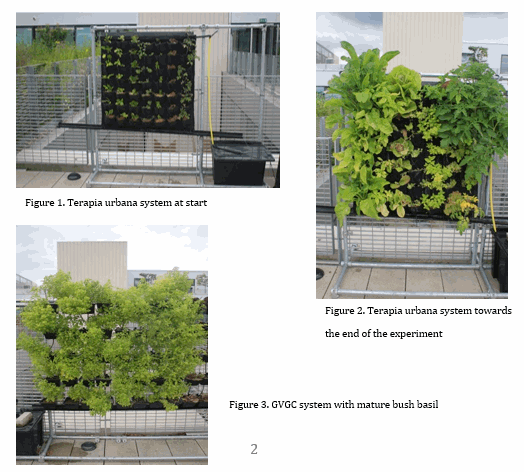THE POTENTIAL FOR COMBINING LIVING WALL AND VERTICAL FARMING SYSTEMS IN AQUAPONICS
Introduction
Aquaponics can be seen as a promising and sustainable solution to overcome the looming food crisis. Growing more food in urban areas is seen as part of the solution and Konig et. al. (2016) note that as food security and infrastructure become a central issue in these urban areas, aquaponics offers one solution. Now that aquaponics is becoming more mainstream, the question that needs to be asked is, can aquaponics be made even more productive and thus more sustainable and how can this be done? This paper focuses on one aspect of aquaponics and the potential for aquaponics to be more sustainable by combining aquaponics with living wall and/or vertical farming systems to provide more sustainable food.
Most aquaponic systems such as the University of the Virgin Island (UVI) system, designed by Dr Jim Rakocy and his colleagues use horizontal grow tanks or beds, emulating traditional land based arable growing to produce vegetables. However, over the years new living wall and vertical farming technologies have arisen and evolved which, when linked to the aquaculture part of the aquaponics system may allow more plants to be grown in comparison to horizontal beds and thus make the systems more productive and thus more sustainable. Depending on the vegetable species the UVI aquaponic systems produce approximately 32 plants per square metre (Al-Hafedh et. al., 2008), but approximately 98 plants can be grown per square meter using back-to-back elements of the Terapia Urbana living wall system which is more than 3 times the density compared to the UVI horizontal growing system.
Materials and Methods
In order to ascertain the effectiveness of vertical aquaponics, a number of considerations needed to be studied. These include: The spatial arrangements of vertical versus horizontal aquaponics. This raises issues of 1) access for maintenance, management and ergonomics; 2) lighting; 3) pumping; and in particular 4) growing media suitability. This paper concentrates on identifying suitable living wall systems, compatible with aquaponics, the spatial arrangements as well as on growing media suitability for growing vegetables in living walls.
Three experiments were undertaken over the summer / autumn of 2016. At the outset of this research, two different living wall systems were chosen as they were considered to be the most suitable for linking with aquaponics. The choice was based mainly on the flexibility and ease of erection, but additional analysis is required to determine costs and sustainability. The two living wall systems chosen were the Terapia Urbana system (Figure 1), and the Green Vertical Garden Company (GVGC) system (Figure 2).
Results and Discussion
Experiment 1 (Figures 1 and 2)
In Experiment 1, a variety of vegetables were tested with a range of growing media within a 'Terapia Urbana' fabric pocket based system. Mineral wool and vermiculite were the best performing substrates, but as plants matured, overshadowing and light became an issue. In external conditions wind is also and issue.
Experiment 2 (Figure 3)
Bush basil (Ocimum basilicum minimum) was planted using the 'Green Vertical Garden Company' (GVGC) plastic pot system. Hydroleca, vermiculite, mineral wool and coconut fibre were used. The best performing substrate was horticultural grade coconut fibre with an average growth per plant of 24.2cm.
Experiment 3
Experiment 3 comprised of an offshoot of Experiment 2 using the GVGC system and single species of Chicory (Cichorium intybus) with two vertical columns each of hydroleca, vermiculite, mineral wool, and coconut fibre (Figure 3). Coconut fibre was again found to provide the best growing medium.
The experiments provided significant insight into the use of living walls for growing vegetables as part of an aquaponic system and in particular insight into the different types of substrate which became evident through the analysis of root structure within the different growing media.
Conclusions
The results of the three experiments indicate that vertical farming and the use of living wall technologies is a promising area to be integrated into the aquaponics. Coconut fibre was found to be the best growing medium and mineral wool was found to be second best. Issues that arose through the management of the research indicate that not all living wall systems are the same and that plant root penetration through the substrate is a key factor. If the roots can penetrate the material of the living wall this will cause problems in harvesting. Irrigation is also an issue that is key to the success of vertical aquaponics.
Al-Hafedh, Y.S., Alam, A., Beltagi, M.S. 2008. Food Production and Water Conservation in a Recirculating Aquaponic System in Saudi Arabia at Different Ratios of Fish Feed to Plants. Journal of World Aquaculture. Society. 39, 510-520.
Konig, B., Junge, R., Bittsanszky, A., Villarroel, M., & Komives, T. 2016. On the sustainability of aquaponics. Ecocycles 2(1): 26-32.
